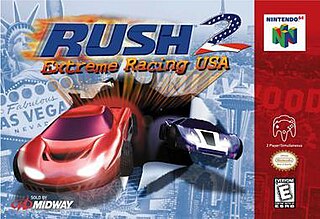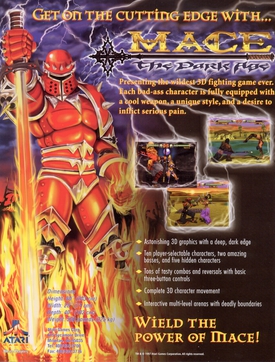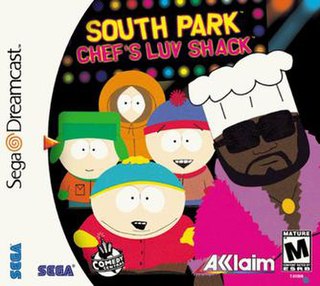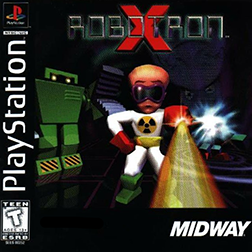
Robotron: 2084 is a multidirectional shooter developed by Eugene Jarvis and Larry DeMar of Vid Kidz and released in arcades by Williams Electronics in 1982. The game is set in the year 2084 in a fictional world where robots have turned against humans in a cybernetic revolt. The aim is to defeat endless waves of robots, rescue surviving humans, and earn as many points as possible.

Chameleon Twist is a 1997 video game developed by Japan System Supply, published by Japan System Supply in Japan, and published by Sunsoft in North America and Europe for the Nintendo 64.

Rush 2: Extreme Racing USA is a racing video game developed by Atari Games and published by Midway exclusively for the Nintendo 64 video game console. It was released on November 11, 1998, in North America, and February 4, 1999, in Europe. Rush 2: Extreme Racing USA is a sequel to San Francisco Rush: Extreme Racing, and the second game in the Rush series.

War Gods is a 3D fighting video game originally released to arcades by Midway Games in 1996. Ports for the Nintendo 64, PlayStation and Windows were released in 1997. In the game, players control one of ten fighters who have been given great power by a mysterious ore that crashed-landed on Earth from outer space. The object of the game is to defeat all the other fighters to become the most powerful warrior on the planet.

Rampage World Tour is an arcade video game released by Midway Games in 1997 as the sequel to Rampage. It was developed at Game Refuge by Brian Colin and Jeff Nauman, who designed the 1986 original. Ports were released for the Sega Saturn, Nintendo 64, Game Boy Color, PlayStation, and Microsoft Windows. It was re-released on Midway Arcade Treasures 2 and included in Rampage: Total Destruction.

Mace: The Dark Age is a fighting video game released by Atari Games for arcade machines in 1997 and later ported by Midway Games to the Nintendo 64. Like many fighting games of the time, its style is marked by extreme violence, with characters graphically slaying defeated opponents. Utilizing 3dfx Voodoo chips for the hardware, the game received attention for its cutting-edge graphics and turned Atari a profit in the arcades. Critical response to the gameplay was much less enthusiastic.

Fighters Destiny, known in Japan as Fighting Cup, is a 1998 video game developed by Genki alongside Opus Corp for the Nintendo 64. It closely models the 3D fighting game standard set by Sega's Virtua Fighter, but integrates a unique point scoring system. The game's generic characters and unoriginal presentation have been panned by critics, but reviewers praised its point system and consider it to be one of the best fighting games on the Nintendo 64. It was followed by a sequel, Fighter Destiny 2, released in 2000.

Space Station Silicon Valley is a platform video game developed by DMA Design and published by Take-Two Interactive. It was originally released for the Nintendo 64 in October 1998. An adaptation of the game for Game Boy Color was developed by Tarantula Studios and released in 1999. A PlayStation port, developed by Runecraft, was released in 2000, under the name Evo's Space Adventures. Players control Evo, a robot reduced to a crawling microchip after a ship crash, and are tasked with taking control of animals to solve puzzles and defeat enemies.

WWF War Zone is a professional wrestling video game developed by Iguana West and released by Acclaim Entertainment in 1998 for the PlayStation, Nintendo 64, and Game Boy. The game features wrestlers from the World Wrestling Federation (WWF).

South Park: Chef's Luv Shack is a 2D game show-style party video game and is a sequel to the 1998 video game South Park, itself based on the American animated sitcom of the same name. Developed by Acclaim Studios Austin and published by Acclaim Entertainment, it was released in 1999 for the Dreamcast, Microsoft Windows, PlayStation and Nintendo 64. Its gameplay involves playing minigames and the ability to play against other players in a challenge for the most points. It also involves trivia questions about South Park and other topics.

The Dual Analog Controller is Sony's first handheld analog controller for the PlayStation, and the predecessor to the DualShock; the first analog controller was the PlayStation Analog Joystick (SCPH-1110).

Dark Rift is a 1997 3D fighting video game for the Nintendo 64 and Microsoft Windows, developed by Kronos Digital Entertainment and published by Vic Tokai. It is notable for being the first N64 game to run at 60 frames per second. Dark Rift is considered the sequel to 1995's Criticom.

The Nintendo 64 controller is the standard game controller for the Nintendo 64 home video game console. It was first manufactured and released by Nintendo on June 23, 1996, in Japan; in September 29, 1996, in North America; and March 1, 1997, in Europe. It is the successor to the Super Nintendo controller and is designed in an "M" shape and features 10 buttons, a "Control Stick", and a D-pad.

AeroGauge is a hovercraft racing game designed for the Nintendo 64 game console and released in 1998. The game was developed by Locomotive and published by ASCII. It is conceptually similar to Psygnosis' Wipeout or Acclaim's Extreme-G. The main difference is that the vehicles in the game fly instead of hovering. AeroGauge garnered mediocre reviews, with criticism directed at its routine concept, excessive pop up, lack of weapons and power-ups, and overly high difficulty.

G.A.S.P!! Fighters' NEXTream, known in North America as Deadly Arts, is a 1998 fighting game developed by Konami Computer Entertainment Osaka and published by Konami for the Nintendo 64. The story follows a series of fighters that have each received a mysterious letter to compete in a legendary contest, and about a champion that has disappeared. The story and the player profiles do not appear in the instructions for the North American version; except for the title, it is basically the same as the Japan and Europe versions, with slightly changed voice messages, and different character nameplates.

Hot Wheels Turbo Racing is a racing video game released for the Nintendo 64 and PlayStation in 1999. It features 40 cars based on the Hot Wheels series of toys. It also features Kyle Petty's 1999 NASCAR stock car, as it was sponsored by Hot Wheels. The game features music from artists like Primus, Metallica, The Reverend Horton Heat and Mix Master Mike.

NBA In The Zone '99, known in Europe as NBA Pro 99, is a basketball game for the Nintendo 64 and PlayStation, released in 1999. It is the fourth installment of the NBA In The Zone series. The game has two covers of NBA All-Star Glen Rice,.

Gex: Enter the Gecko is a 1998 platform game developed by Crystal Dynamics for the PlayStation, Nintendo 64, Microsoft Windows, and Game Boy Color. It was released in 1998 and 1999 in North America, Europe, and Japan. The game is the second installment of the Gex video game series and the first with 3D graphics. Its protagonist, Gex, a TV-binging, wisecracking gecko, seeks to collect three types of remotes to unlock different TVs in the overworld that aid in the fight against his arch-nemesis, Rez.

Robotron X is a multidirectional shooter video game co-developed by Leland Interactive Media and Player 1 and it was released by Midway Games in November 1996 for the PlayStation. It is a 3D version of the 1982 dual-stick shooter Robotron: 2084. GT Interactive published a Microsoft Windows port in 1997. A Nintendo 64 version was released in 1998 as Robotron 64, and Crave Entertainment bought out the publishing rights to the N64 version.

NFL Blitz is an American football video game developed and published by Midway for the arcade in 1997, the first game in the NFL Blitz series. The development team was headed by Mark Turmell and Sal Divita, who were known for being behind NBA Jam, and NFL Blitz was a deliberate attempt to translate the exaggerated arcade-style approach of NBA Jam to the football realm. The game was ported to the PlayStation, Nintendo 64, Windows, and Game Boy Color in 1998. The cover athlete for the game was then Pittsburgh Steelers quarterback Kordell Stewart.



















